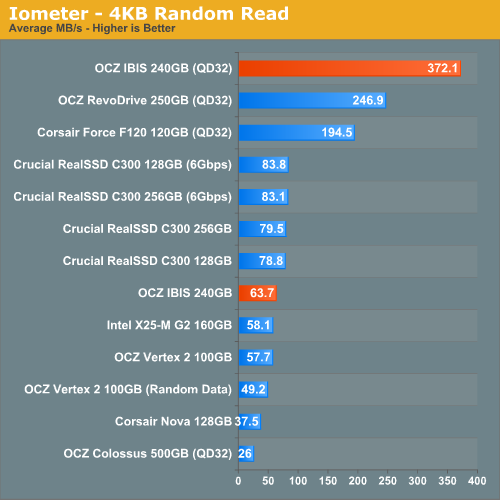OCZ's Fastest SSD, The IBIS and HSDL Interface Reviewed
by Anand Lal Shimpi on September 29, 2010 12:01 AM ESTMaking Random Performance Look Sequential
The four corners of SSD performance are as follows: random read, random write, sequential read and sequential write speed. Random accesses are generally small in size, while sequential accesses tend to be larger and thus we have the four Iometer tests we use in all of our reviews.
Our random tests write 4KB in a completely random pattern over an 8GB space of the drive to simulate the sort of random access that you'd see on an OS drive (even this is more stressful than a normal desktop user would see). Our random read test spans the entirety of the drive. I perform three concurrent IOs and run the test for 3 minutes. The results reported are in average MB/s over the entire time.

In case you didn't do the math in your head, 510MB/s of 4KB random writes translates to 130,000 IOPS. That's insane. The IBIS can deliver faster random writes than the RevoDrive can manage sequential writes. A fully taxed SandForce drive manages 200MB/s, the performance advantage here is huge. Again I can't stress enough how fast four of these things must be.

Random read performance across the drive's entire LBA space drops the peak performance a bit but we're still well beyond what 3Gbps SATA can deliver, although technically 6Gbps SATA would be enough here. You'll note that in a desktop workload (QD=3) there's no advantage to the IBIS drive. This thing really only makes sense for very I/O intensive workloads.










74 Comments
View All Comments
clovis501 - Wednesday, September 29, 2010 - link
If this innovation will eventually make it's way down to personal computer, it could simplify board design by allowing us to do away with the ever-changing SATA standard. A PCI Bus for all drives, and so much bandwidth than any bus-level bottleneck would be a thing of the past. One Bus to rule them all!LancerVI - Wednesday, September 29, 2010 - link
One bus to rule them all! That's a great point. One can hope. That would be great!AstroGuardian - Wednesday, September 29, 2010 - link
I want AT to how me how long will it take to install Windows 7 from a fast USB stick, install all the biggest and IO hungry apps. Then i want to see how long will it take to start them all @ the same time having been put in the Start-up folder. Then i want to see how well would work 5 virtual machines doing some synthetic benchmarks (each one @ the same time) under windows 7.Than i will have a clear view of how fast these SSD monsters are.
Minion4Hire - Wednesday, September 29, 2010 - link
Well aren't you demanding... =pPerisphetic - Thursday, September 30, 2010 - link
...or the past.Well it's probably deja vu, sounds like it.
This is exactly what the MCA (Micro Channel architecture) bus did.back in the day. My IBM PS/2 35 SX's hard drive connected directly to this bus which was also the way the plug in cards connected...
jonup - Wednesday, September 29, 2010 - link
"Even our upcoming server upgrade uses no less than fifty two SSDs across our entire network, and we’re small beans in the grand scheme of things."That's why the prices of SSD stay so high. The demand on the server market is way to high. Manufacturers do not need to fight for the mainstream consumer.
mckirkus - Wednesday, September 29, 2010 - link
I hate to feed trolls but this one is so easy to refute...The uptake of SSDs in the enterprise ultimately makes them cheaper/faster for consumers. If demand increases so does production. Also enterprise users buy different drives, the tech from those fancy beasts typically ends up in consumer products.
The analogy is that big car manufacturers have race teams for bleeding edge tech. If Anand bought a bunch of track ready Ferraris it wouldn't make your Toyota Yaris more expensive.
Flash production will ramp up to meet demand. Econ 101.
jonup - Wednesday, September 29, 2010 - link
Except that there is a limited supply of NAND Flash supply is limited while the demand for Ferraris does affect the demand for Yarises. Further, advances in technologies does not have anything to do with the shortage for Flash. Still further, supply for flash is very inelastic due to the high cost of entry and possibly limited supply of raw materials (read silicon).p.s. Do yourself a favor, do not teach me economics.
jonup - Wednesday, September 29, 2010 - link
Sorry for the bump, but in my original massage I simply expressed my supprise. I was not aware of the fact that SSD are so widely available/used in the commercial side.Ushio01 - Wednesday, September 29, 2010 - link
I believe the random write and read graphs have been mixed up.